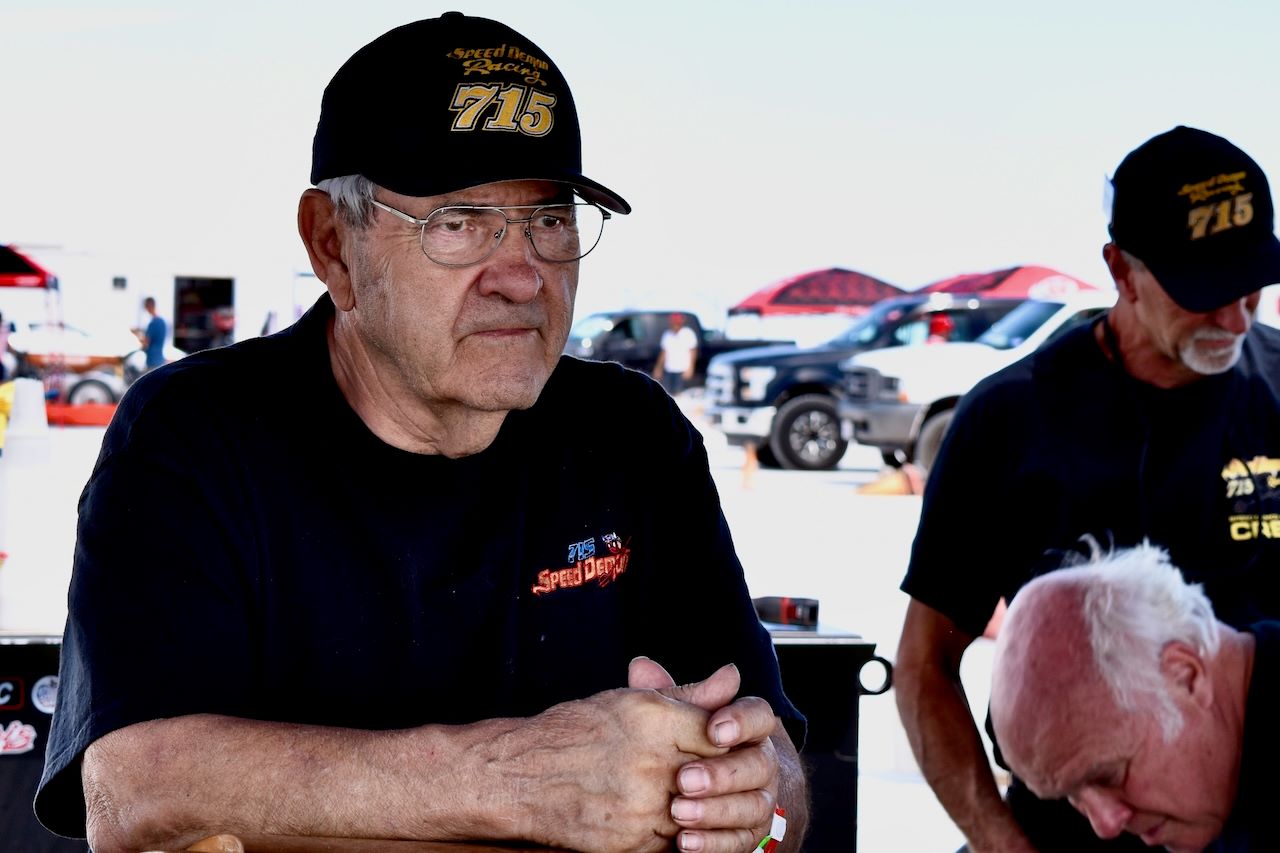Using a diverse selection of twin-turbo big-block Chevy, LS and small-block Chevy engines—along with a Mopar four-banger—the celebrated Speed Demon 715 Bonneville streamliner holds six land-speed records, and over 12 years has won the Hot Rod trophy each event as the fastest car on the salt flats. It currently holds the record as the fastest piston-driven land-speed vehicle with a 470.015 mph two-run average over the measured mile and recorded an exit speed of 481.576 mph.
However, there is one record that is easily within the team’s grasp but has slipped away on every run in the past three years. And it involves the smallest V8 engine in the Demon stable: a big-bore, short-stroke 255ci SBC that easily pulls 2,000-plus horsepower with 50 pounds or more of boost.

“Yeah, we’ve had issues with that engine,” says Steve Watt, owner of Maxwell Industries, the builder of the Speed Demon. “It’s aggravating the heck out of us,” echoes engine builder Kenny Duttweiler. “Yeah, that engine is beating us to death, but I think we’re going to win this war.” The speed record is 348.150 mph in the E/Blown Fuel Streamliner (E/BFS) class. The mark has stood since 1995, held by Harry Hoffman Jr. in the Hoffman-Markley entry. Currently, the Demon team owns the AA/, A/, B/, C/, D/, and F/BFS records, leaving only the E/ class record out of the streak. The late George Poteet was behind the wheel when the Demon established those records. During last year’s 2024 Speed Week, Chris Raschke took over the driving duties and upped the B/BFS record to 432.274 mph. But the E/BFS eluded him.

The E/ class has a maximum displacement of 260ci, so the Demon team works with a 255ci platform that is achieved with a 4.170-inch bore and a 2.350-inch stroke. Two different foundations have been used in this record attempt. The first started with a Dart Iron Eagle cylinder block that was specially cast to achieve a deck height of 8.200-inch. Two engines were built and both suffered rear main-bearing failures that was determined to be the result of a throwout-bearing-clearance issue. Basically, the engine was spinning so fast that the clutch fork pushed the throwout bearing against crankshaft and took all the thrust out of the rear main.

“On one run, I think the problem occurred at 2.3 seconds into the run and took out two cylinders,” remembers Duttweiler. “But Chris went and ran through the five-mile, running 390 mph on six cylinders.” If the team had patched up the oil pan and made the required back-up run, they probably would have the record. But there was a much bigger goal. “We’re projecting that 255 could probably go somewhere in the area of 430 or 435 easily,” says Duttweiler. The latest engine was built using a Dart 9.000-inch deck-height block with necessary lifter-bore-angle upgrades to facilitate the Dart Little Chief cylinder heads. The taller deck height also required installing 6.300-inch Dyer’s connecting rods, compared to the 5.900-inch rods used in the short-deck engines.

“You could say we might be abusing the rod-ratio principle. It’s 2.68:1. If you go on what people theorize, that’s probably not the way to go,” says Duttweiler, admitting some issues had to be addressed—such as changing the timing map. “But it seems to work extremely well with these turbocharged engines. The biggest thing is the rod weight. We overkill it at 940 or 950 grams, so you’re swinging a lot of weight and turning a lot rpm. The only downside is that you probably have a crankshaft that likes to move around the block a little bit more than you might expect. But we’ve never had piston or pin issues.”

The Scat billet crankshaft is machined with 2.650-inch main journals and 2.100-inch rod journals. With the short 2.350-inch stroke, the crankshaft has significant journal overlap for added strength. Duttweiler carried over the high-flowing, symmetrical-port cylinder heads (2.300-inch intake, 1.550-inch exhaust valves) and fuel system. “It’s got the same intake, a rather large camshaft that’s good for 11,000 rpm, and 8.5:1 compression ratio. It just makes insane horsepower, but it does it all from about 9,000 to 10,000,” says Duttweiler. “It’ll make literally no boost until it gets to about 8,000. By 9,000, it’s up to 15 or 18 pounds. By 9,000 rpm it’s up to 15 or 18 pounds, and by 9,500 it’s up to 50. The graph looks almost like a two-stroke engine.” To simplify engine swaps in the pit, all the engines run with the same twin-turbo/ice-filled intercooler package. Duttweiler just swaps the intermediate pipes between the headers and the turbos. For this year, the team installed a new set of Precision Pro Mod 88 turbos with a slightly smaller compressor wheel and modified trim on the turbine wheel.
“The back pressure is well below the manifold pressure,” explains Duttweiler. “If you look at the displacement versus boost—because boost is restriction to flow—the smaller the engine gets, the more boost you have to move the same amount of air. So, when we’re talking 60 pounds of boost on that engine, that might only be 35 pounds of boost on the big block, because you’re filling a much bigger container. This engine went 390-plus on 35 pounds, so there’s a whole new world above 35 pounds for that sized engine.”

While the 2024 engine was poised to make tremendous power, the oil pump presented another unexpected challenge. The team generally runs 120 psi oil pressure with a 50-psi safety shutoff. During the first run, oil pressure fell to 50 psi somewhere in the fourth mile. The engine again quit at 50 psi on the following run, and then during the third run the engine spun the bearings. “It must have been a clearance problem in the scavenge section. It literally wasn’t pulling the oil out of the pan,” says Duttweiler. “It had a really good pressure section and put about 12 gallons of oil through the motor. But the scavenge side was returning only five or six. We have an oil-level sensor in the dry-sump tank. Twenty seconds or so into the run, you could see the oil level go down substantially. When it gets down to five quarts in the tank, that’s a bad situation because all the oil is in the pan. It actually generates its own little windmill in there.
Once we fixed the pump, it literally pulled vacuum like you couldn’t believe.” For the 2025 season, the 255ci engine will benefit from a thorough teardown and autopsy of the damage. Duttweiler is looking close at all elements of the lubrication system, including working closely with the oil-pump manufacturer and reviewing bearing design. The team will run the same combination, even though many the engine’s components were pirated from a larger 390 engine because they were available. “There really was no attempt to really size the parts to that engine,” admits Duttweiler. “With a large plenum and runners on the intake manifold and a large cam, I think that’s why we have such an elevated power band on this small engine.”



